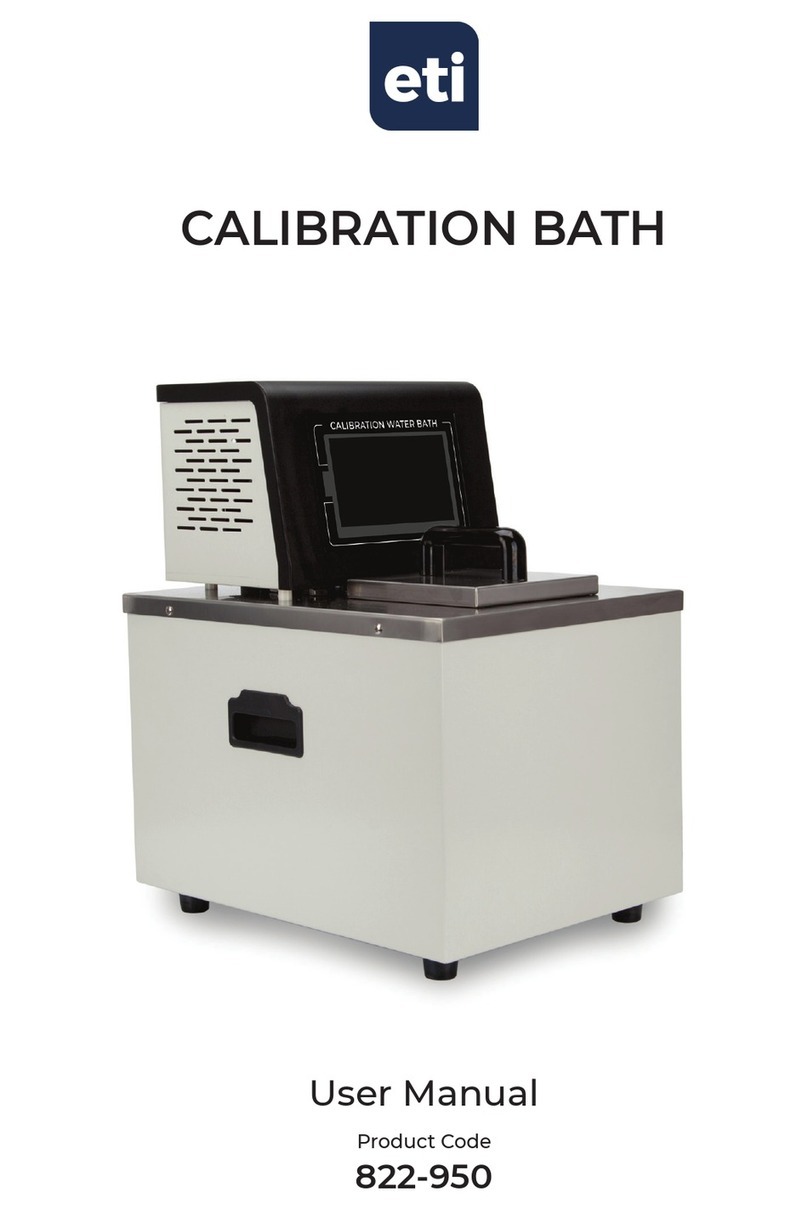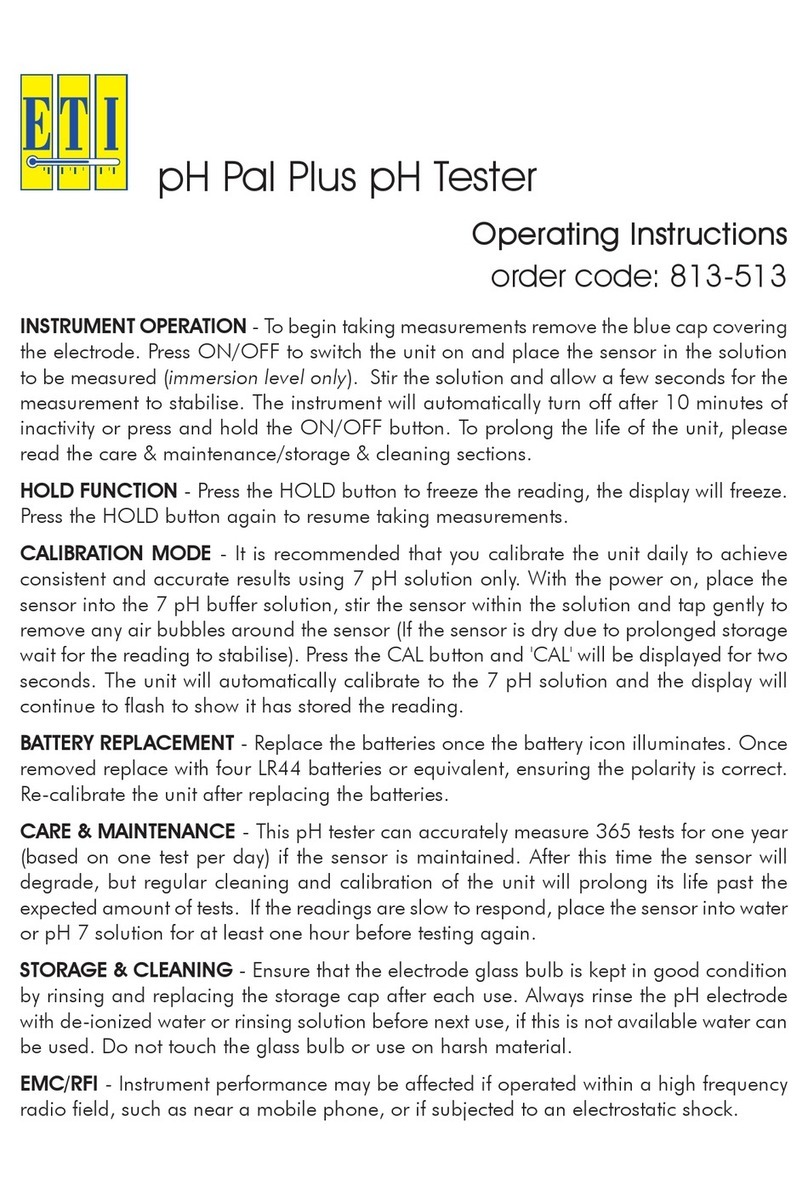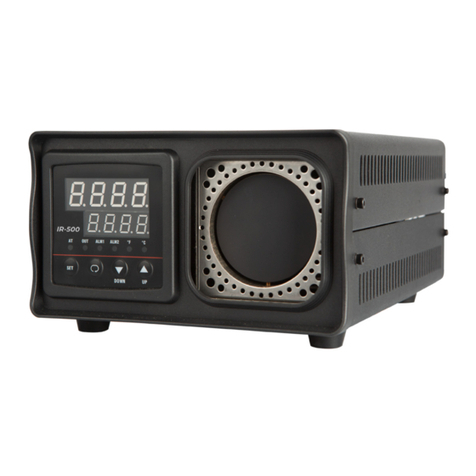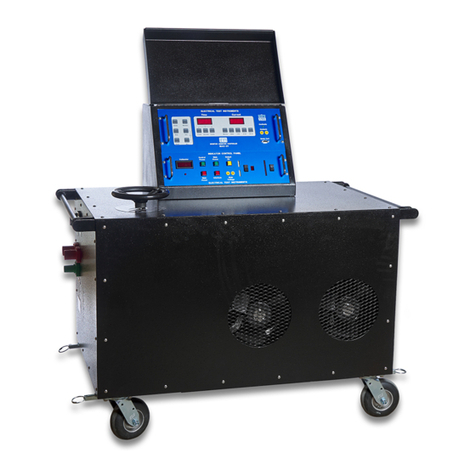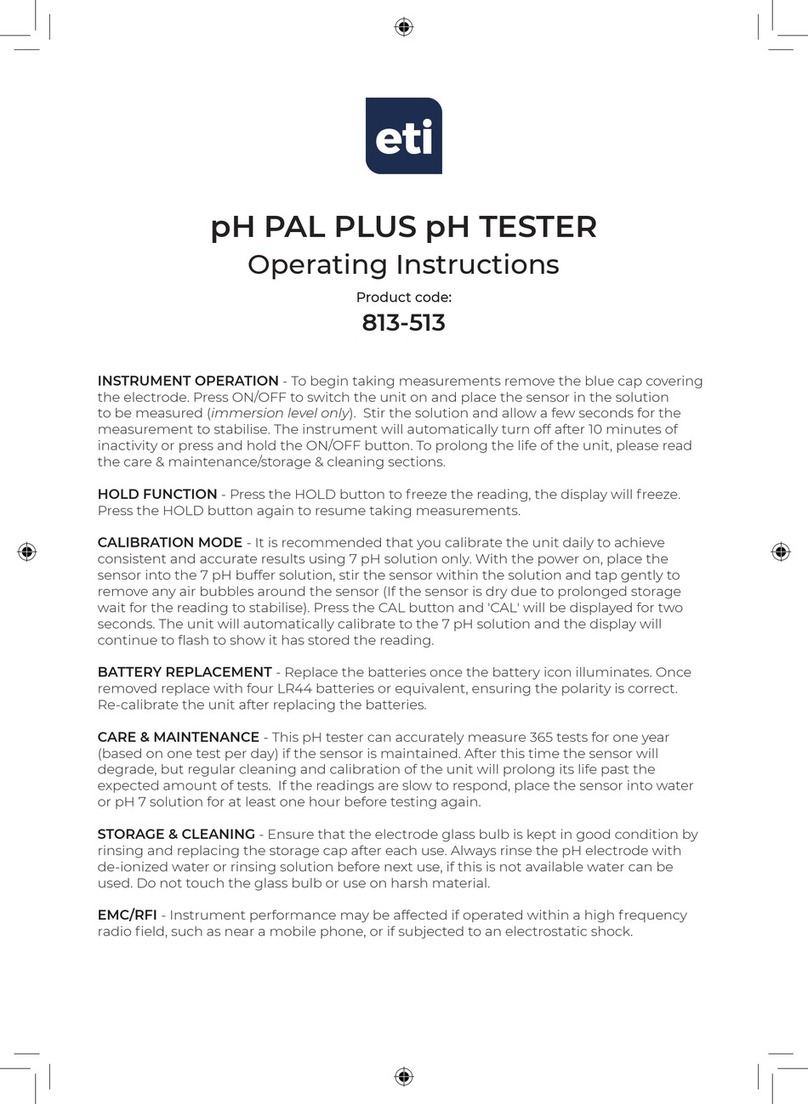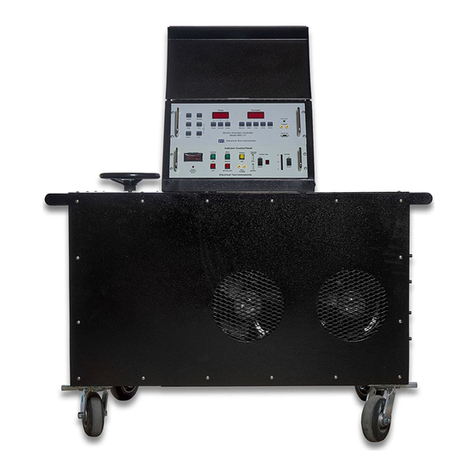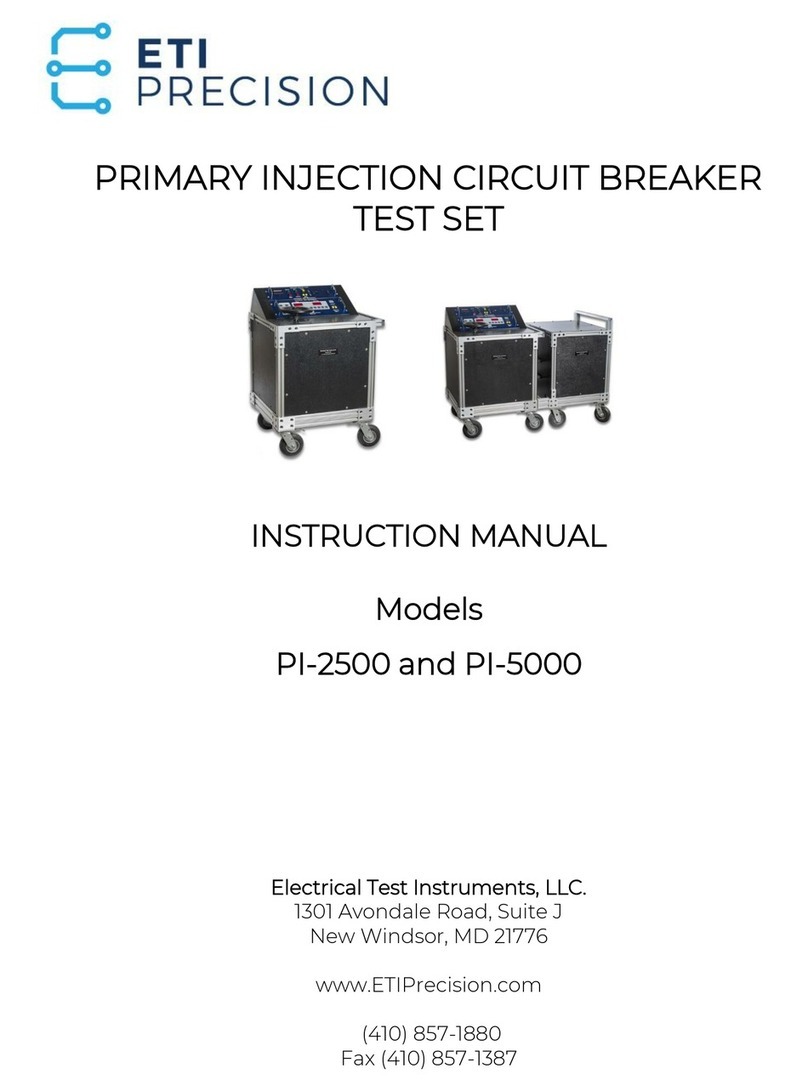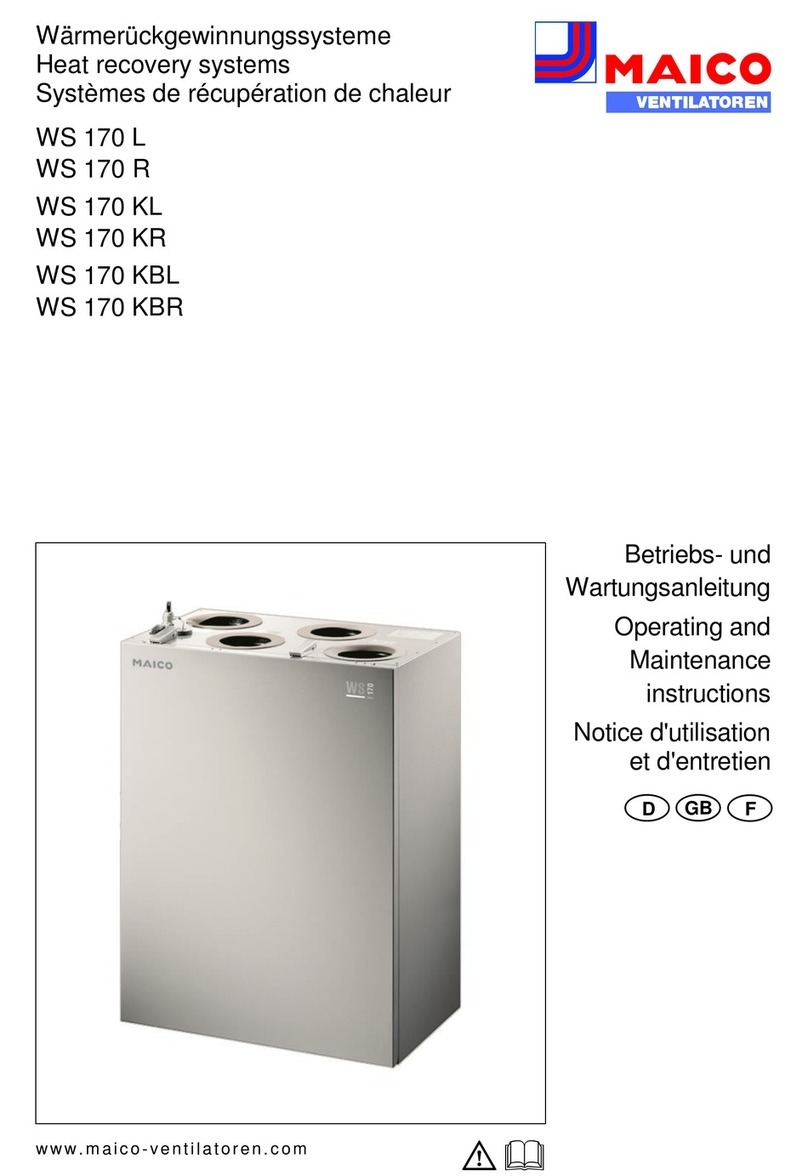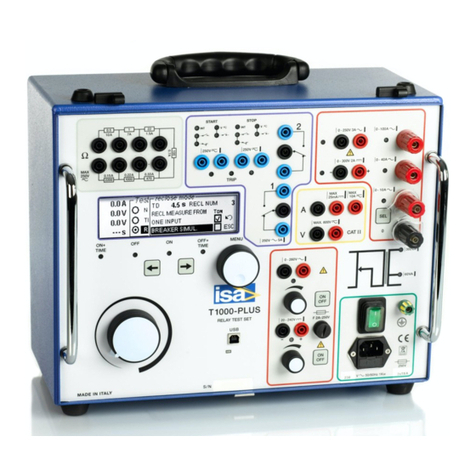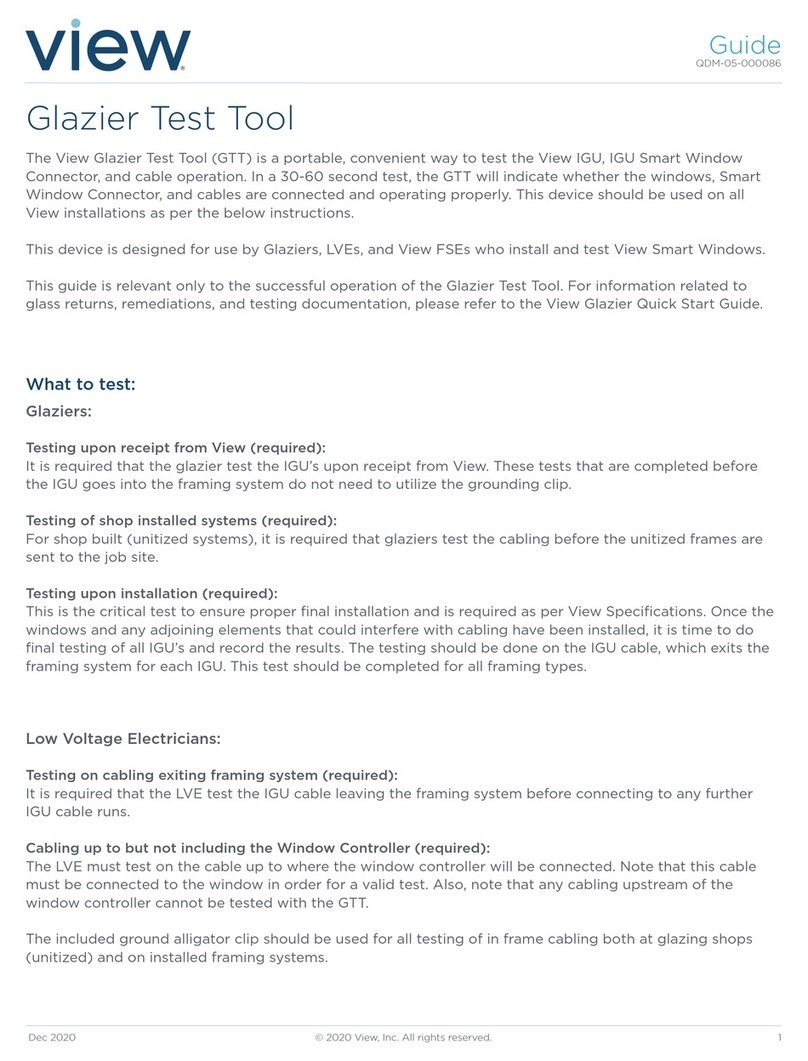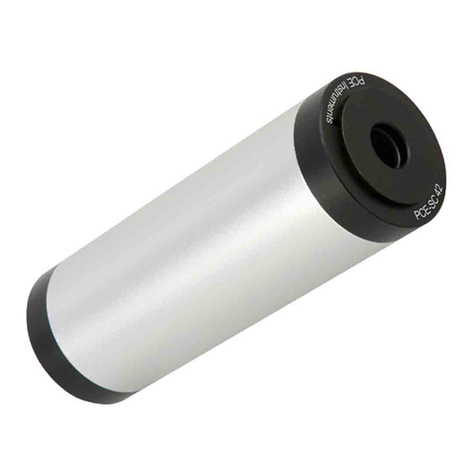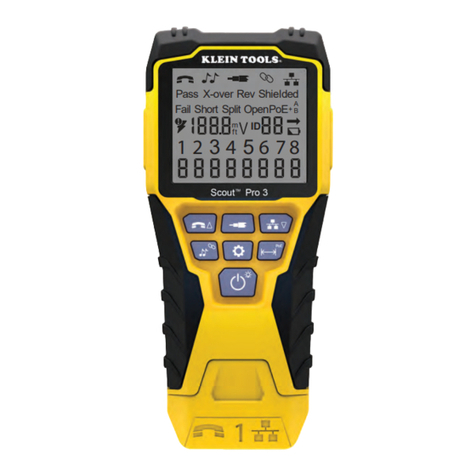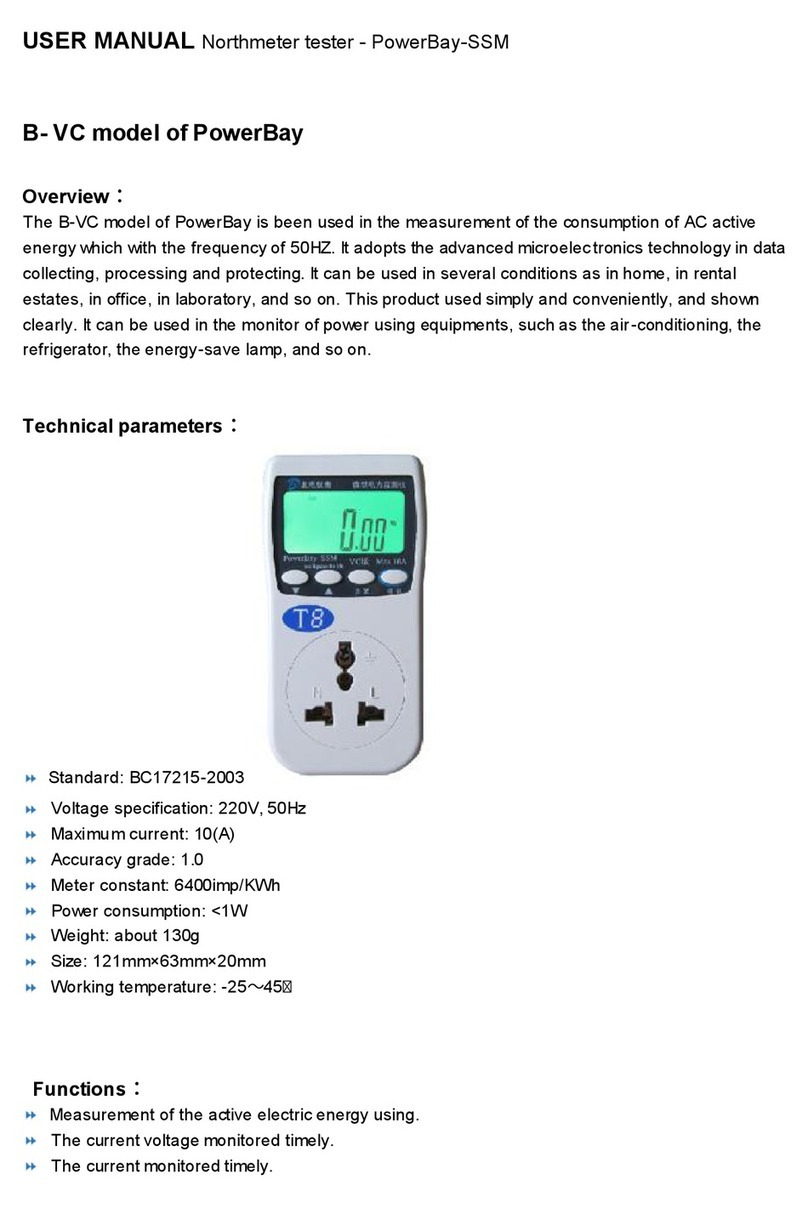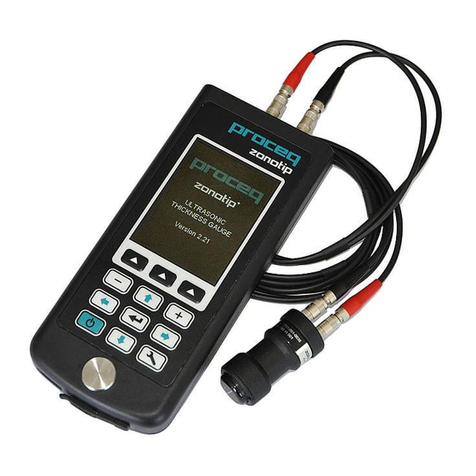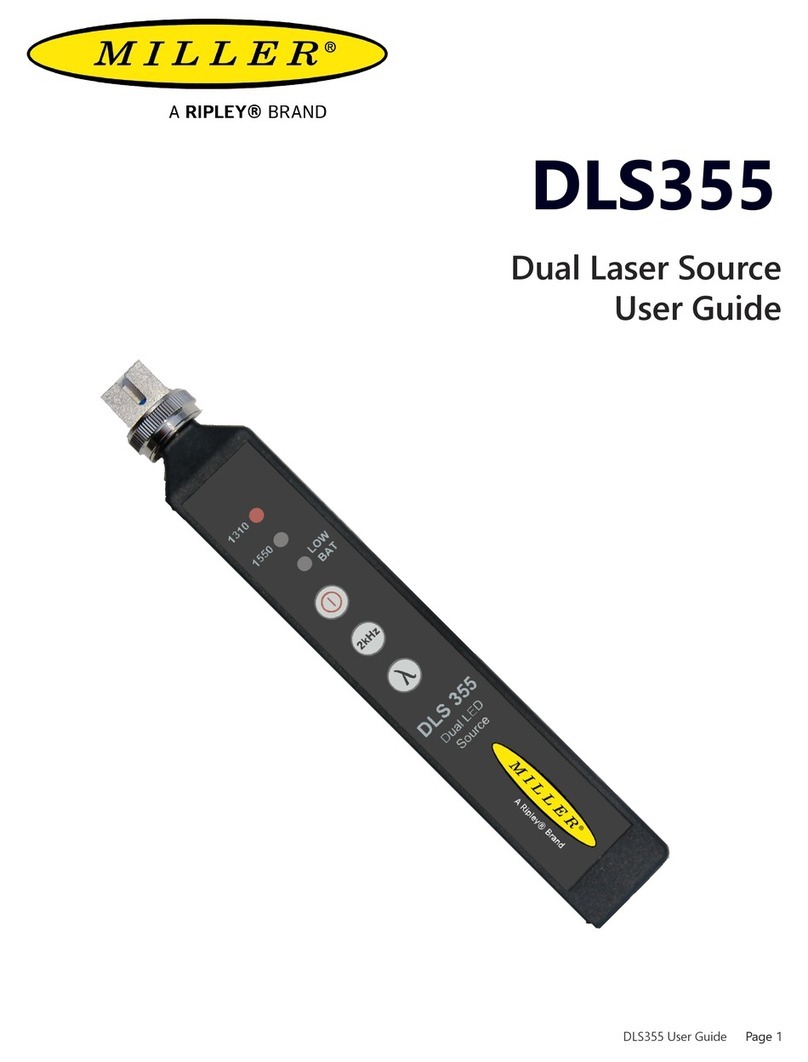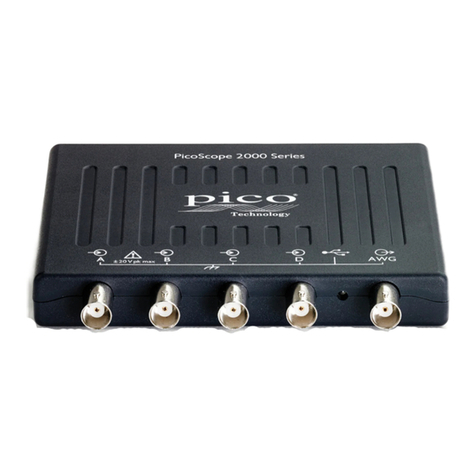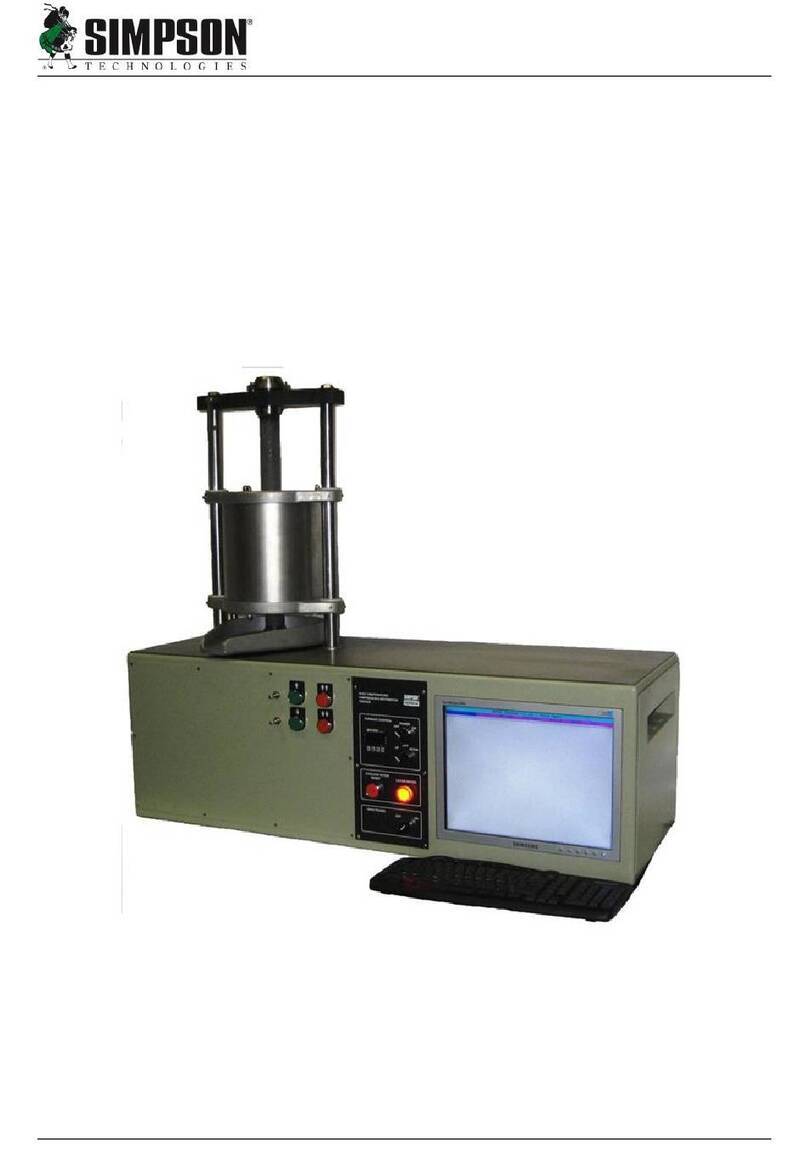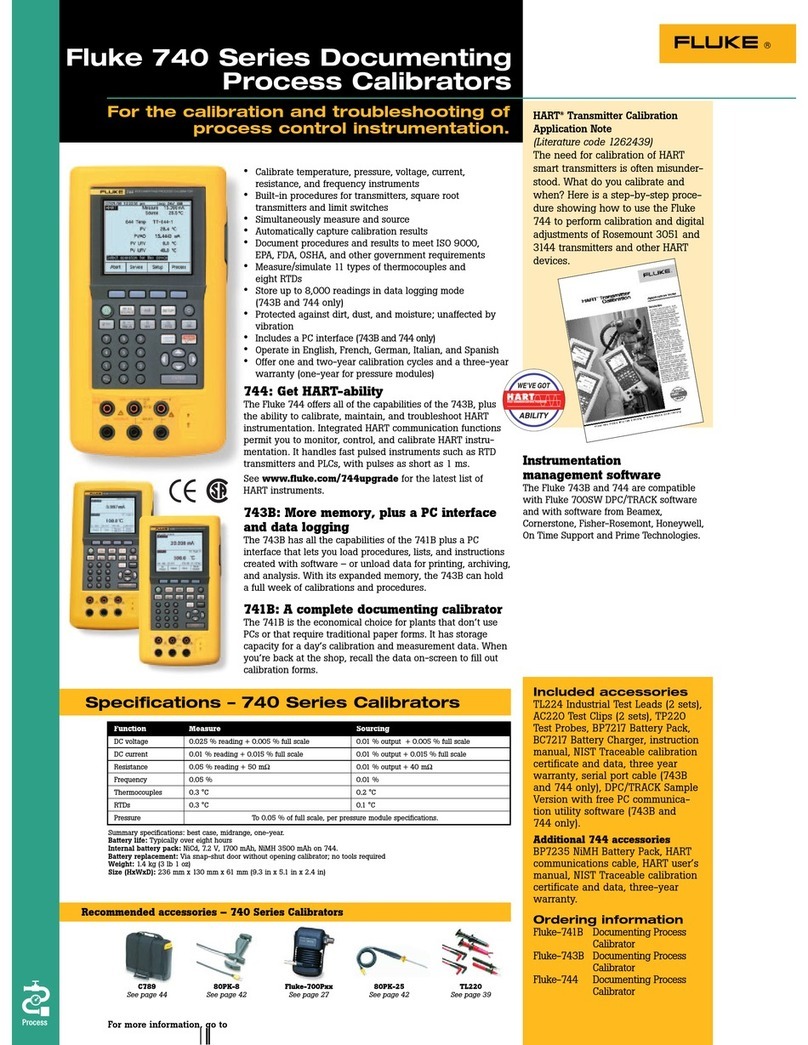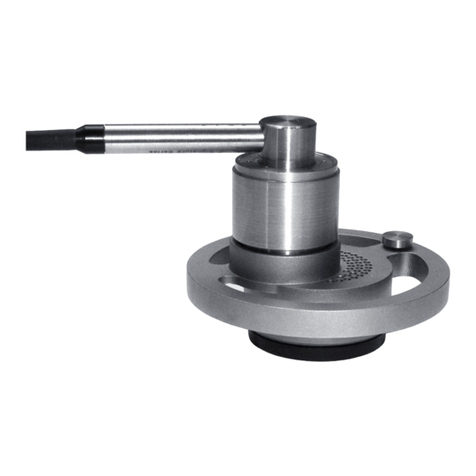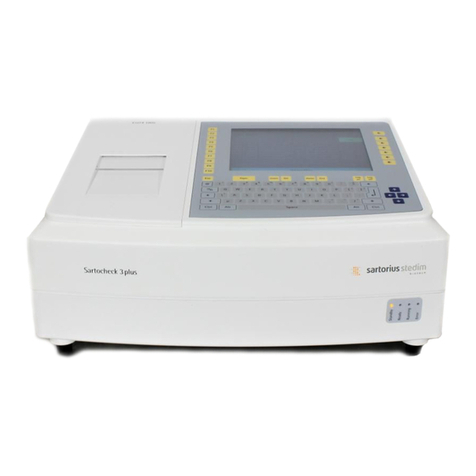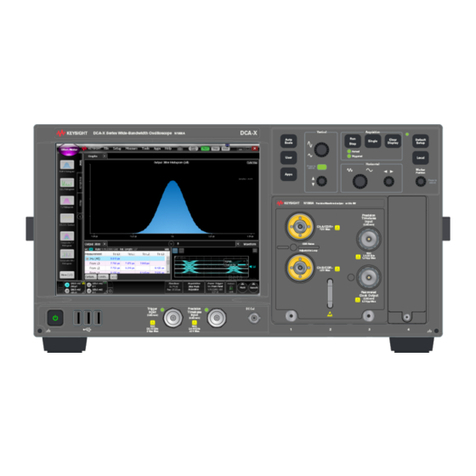ETI PI-800 User manual

PRIMARY INJECTION CIRCUIT BREAKER
TEST SET
INSTRUCTION MANUAL
Models
PI-800 and PI-1600
Electrical Test Instruments, LLC.
1301 Avondale Road, Suite J
New Windsor, MD 21776
www.ETIPrecision.com
(410) 857-1880
Fax (410) 857-1387

Electrical Test Instruments PI-800 and PI-1600
==============================================================================
==============================================================================
Copyright (C) 1994-2003 Electrical Test Instruments, LLC. All Rights Reserved
TABLE OF CONTENTS
SECTION I: GENERAL INFORMATION and SPECIFICATIONS
WARNING I-1
Introduction I-2
General Description I-2
Monitor and Controller MAC-21 I-5
Proposed Enhancements I-5
Advantages Compared to Other Test Sets I-6
Trademarks I-6
MAC-21 Specifications I-7
PI-800 Specifications I-8
PI-1600 Specifications I-9
SECTION II: DETAILED DESCRIPTION
Theory of Operation
High Current Test Sets II-1
PI-800 Main Circuitry II-1
PI-AUX Boost Unit Circuitry II-3
Major Parts Identification and Operation II-3
SECTION III: MAC-21 Monitor and Controller
MAC-21 Specifications III-1
MAC-21 Unit Circuitry III-2
MAC-21 Software III-2
MAC-21 Parts Identification and Operation III-4
MAC-21 Internal Parts III-8
Figure II-1: Front Panel III-9
Maintenance and Calibration of MAC-21 III-10
Parts List (MAC-21) III-12
Overall Schematic (MAC-21) III-13
SECTION IV: OPERATING INSTRUCTIONS
Pre-Test Installation and Setup IV-1
Output Connection Diagram IV-2
Basic Guidelines and Suggestions IV-3
Duty Cycle Ratings IV-3
Single Pole Molded Case Breakers IV-5

Electrical Test Instruments PI-800 and PI-1600
==============================================================================
==============================================================================
Copyright (C) 1994-2003 Electrical Test Instruments, LLC. All Rights Reserved
Multi-pole Molded Case Breakers IV-8
Low Voltage Power Breakers IV-11
Motor Overload Relays IV-15
Ratioing Current Transformers IV-17
SECTION V: SERVICE INFORMATION AND DOCUMENTATION
Maintenance and Calibration of PI-800/1600 V-1
Maintenance and Calibration of MAC-21 V-1
Parts List (PI-800) V-4
Parts List (PI-AUX) V-5
Warranty V-6
Overall Schematics END

Electrical Test Instruments PI-800 and PI-1600
Section I - General Information and Specifications
==============================================================================
==============================================================================
Copyright(C) 1994-2003 Electrical Test Instruments, LLC. All Rights Reserved
SECTION I
GENERAL INFORMATION and SPECIFICATIONS
WARNING
WARNING - READ THIS ENTIRE MANUAL AND
THOROUGHLY FAMILIARIZE YOURSELF WITH THE UNIT
OPERATION PRIOR TO CONNECTING THE UNIT TO A
SOURCE OF POWER. HIGH CURRENT TEST SETS ARE
NORMALLY POWERED FROM HIGH CAPACITY 208 VOLT TO
575 VOLT SERVICES, AND IMPROPER CONNECTION OR
OPERATION COULD CAUSE DAMAGE TO THE TEST SET AND
EQUIPMENT UNDER TEST, AS WELL AS CREATE AN UNSAFE
CONDITION FOR PERSONS OPERATING THE SET.

Electrical Test Instruments PI-800 and PI-1600
Section I - General Information and Specifications
==============================================================================
==============================================================================
Copyright(C) 1994-2003 Electrical Test Instruments, LLC. All Rights Reserved
Page I-1
INTRODUCTION
A primary injection test set, such as the PI-800 and PI-1600, is a device with high
current, low voltage AC outputs for testing direct acting low voltage circuit
breakers. Current is injected through the main contacts of the breaker to simu-
late actual fault conditions, which tests the operation of CTs, solid state, thermal,
or electromechanical trip devices, and the actual trip mechanisms and breaker
contacts.
GENERAL DESCRIPTION
The PI-800/1600 Circuit Breaker Test System incorporates modular design and
flexibility to provide unequaled capability in a portable package. The PI-800
used alone, on 120 or 240 VAC supplies, generates continuous current of 400,
800, or 1600 amps at 4.2 kVA, with peak output to over 10x. The PI-Aux boosts
total power to 9.8 kVA, and allows testing of drawout breakers and MCBs to 1600
A. The units are housed in rugged interlocking suitcase-size enclosures. Each
piece weighs no more than 125 pounds, allowing one-person hand truck mobil-
ity. Basic operation is very simple, and the proven MAC-21 provides optimal out-
put control and measurement.
The PI-800 is a versatile and technologically advanced portable primary injec-
tion test set capable of testing circuit breakers up to 800 amperes frame size. It
incorporates a special lightweight toroidal output transformer with dual prima-
ries to facilitate its use on power sources of 120 VAC as well as 240 VAC, and quad
secondaries to provide optimal impedance matching to a wide range of breaker
sizes. Internal fan cooling allows maximum utilization of the output transformer
and faster recovery after overload conditions.
The PI-800 consists of a strong aluminum frame, housed in a rugged plastic and
aluminum enclosure with removable sealed front and back lids for maximum
protection of controls and indicators, as well as storage for test leads, manuals,
etc. All controls, indicators, and input connections are on the front panel. The
versatile 50-amp input plugs may be connected to heavy duty portable cords
with a variety of connectors for 120 VAC, 208 VAC, or 240 VAC. Individual leads
may also be used to connect to buswork. The output connections are on the
rear, along with an auxiliary Output ON indicator, configuration switch, and air
output from the fans, which can help cool cables and breakers. Comfortable re-
cessed side handles provide ease of mobility.
The MAC-21 is supplied in a separate rugged portable case, interlocks on top of
the PI-800, and connects to a cable in the rear of the test set.
The eight-silver plated output bus connectors allow configuration for continu-
ous outputs of 800 amperes at 4.2 VAC, and 400 amperes at 8.4 VAC, for testing
molded case breakers with cables. They can also be connected for 1600

Electrical Test Instruments PI-800 and PI-1600
Section I - General Information and Specifications
==============================================================================
==============================================================================
Copyright(C) 1994-2003 Electrical Test Instruments, LLC. All Rights Reserved
Page I-2
amperes at 2.1 VAC, which can be used for CT testing, heat runs of bus connec-
tions and limited testing of air drawout breakers. They have pressed-in 3/8"-16
stainless steel threaded inserts, which eliminates the need for nuts, and the con-
figuration bars are slotted for quick and easy changing for various breaker sizes.
The PI-Aux is a booster unit which connects to the PI-800 and MAC-21 to create
a powerful two-piece test system for medium size air drawout and molded case
breakers up to 1600 amperes frame size. It also consists of a strong aluminum
frame, housed in a rugged plastic and aluminum enclosure with removable
sealed front and back lids. The output connections are on the rear, along with
an auxiliary Output ON indicator, and air output from the fans, which can help
cool cables and breakers. Comfortable recessed side handles provide ease of
mobility.
For the PI-1600, the PI-800 is placed in interlocking ridges on top of the PI-Aux,
and interconnected by means of simple control and power cables. The MAC-21
connects to the PI-800 by means of a single cable, which allows it to be placed
in the interlocking ridges of the PI-Aux for a three-piece stacked unit. The out-
puts are connected by means of two slotted bus bars, and four connection
plates. A series bar is supplied for continuous current of 800 amps at 10 VAC for
testing smaller breakers that require connection via cables. Larger breakers
may be tested by connecting up to six cables in parallel, for continuous current
of 1600 amps at 5 VAC. It is also possible to configure the output for 400 amps
at 20 VAC for connection to small breakers with long cables. A selector switch
adjusts the internal CT output for proper readings in each of the three configu-
rations.
Optional stab mounting plates may be bolted to the PI-800 and the PI-Aux as
required to provide connection to standard 3 1/2" x 5" stab adapters, with a true
continuous output current rating of 1600 amperes at 5 VAC. Strong, easily re-
placeable stainless steel bolts allow maximum torque to be applied without
concern about breakage or rotation of studs. The edges of the stab mounting
plates provide solid mechanical bracing to the output plates of the two units,
and breakers may be racked in without worrying about bending the buswork.
Standard silver-plated copper stab adaptors, available as an option for the test
set, are designed to be used for both vertical and horizontal stabs, and are avail-
able for ½” and ¾” stab blades.
The test set may be plugged into any 60 Hz AC voltage source of 100-140 VAC
or 200-264 VAC, and will work on 50 Hz sources of 100-120 VAC or 200-220 VAC.
Voltage selection is provided by means of a simple selector switch on the PI-
800 front panel. An internal voltage sensor prevents the main power from being
turned on if the input voltage is incorrect. An optional lightweight Voltage Con-
verter Unit (AT-10) is available to allow the test set to be used to full capacity on
208 VAC or 480 VAC.

Electrical Test Instruments PI-800 and PI-1600
Section I - General Information and Specifications
==============================================================================
==============================================================================
Copyright(C) 1994-2003 Electrical Test Instruments, LLC. All Rights Reserved
Page I-3
The vernier uses a simple knob to adjust the output manually within the range
determined by the coarse tap. Clockwise rotation always increases output,
which reduces confusion.
A convenient rotary switch selects the coarse tap. It activates relays in either the
PI-800 or PI-Aux to provide 7ranges of output for the PI-1600 combined unit.
The indicator/control panel features:
(1) An Input Voltage indicator, which lights whenever power is connected to
the test set
(2) A green Control Power ON switch/indicator, which also turns on the main
output power
(3) An amber Output ON indicator, which lights when output is initiated.
(4) A red Interlock Indicator, which lights if control power is off, or if an inter-
lock open condition exists. It also functions as an output shut-down
switch, which turns off main power.
(5) Three System Status LEDs, which provide information on the internal
temperature of the buswork, as well as duty cycle limitations of the ver-
nier.
(6) Three Output LEDs, which show overcurrent usage of the test set, from 1x
to 10x.
(7) A Bus Overtemperature indicator on the rear, which lights if any bus con-
nection overheats.
Primary catastrophic overload protection for the test set is accomplished with
input fuses having high interrupting current capacity. Overload of the output
system is sensed by means of a Programmable Overload Detector (POD) on the
vernier autotransformer. The POD allows full utilization of the overload capabil-
ity of the test set, and eliminates costly and cumbersome fuse replacement re-
quired in other test sets. It senses actual temperature of the output bus, as well
as duty cycle overload use of the vernier, and provides visual indication by
means of green, yellow, and red LEDs. It will shut down the test set output if
extreme overloads or overtemperatures are detected, and will inhibit re-initia-
tion until there has been sufficient cooling time.
The output of the test set is controlled by means of a proven SCR controller. This
provides precise initial phase angle control to reduce DC offset for inductive
loads and more consistent pulse currents.
The measurement of output current and time is accomplished by means of the
proven MAC-21, which uses highly accurate A/D circuitry and intelligent firm-
ware to resolve true-RMS values of distorted waveforms. It also provides features
such as preset ON times for convenient jogging of output current without over-
heating the breaker or causing unwanted trips.

Electrical Test Instruments PI-800 and PI-1600
Section I - General Information and Specifications
==============================================================================
==============================================================================
Copyright(C) 1994-2003 Electrical Test Instruments, LLC. All Rights Reserved
Page I-4
The MAC-21 is also capable of reading Peak RMS current, which can help detect
waveform distortion on fast trips, as well as Last RMS current, which is useful for
pickup tests. Either value may be displayed after the test is completed. Nor-
mally, the MAC-21 displays the true RMS value of the entire waveform, regard-
less of duration.
The entire test set has been designed for reliability, ruggedness, reasonable
one-person portability, and ease of use. Sophisticated electronics in the MAC-21
provide state of the art accuracy and convenience, while simple connections al-
low for easy disassembly for transportation or service. In the unlikely case of fail-
ure of the MAC-21, in an emergency, it is possible to operate the test set without
it by using a clamp-on ammeter and a simple adapter for initiation.
MONITOR AND CONTROLLER MAC-21
The MAC-21 microprocessor-based measurement and control unit features
digital readout of current and time enhanced by digital signal processing.
Pulse (memory) mode provides fast and accurate automatic evaluation of out-
put current pulses as short as one-half cycle.
The MAC-21 incorporates a precision A/D converter and special firmware for
true-RMS continuous and pulse current reading with much greater accuracy.
It also utilizes a sophisticated current sensing system for more reliable current
latch mode operation and better timing accuracy. An LED digital readout for
current in four ranges from 1000 A to 100 KA reduces the chance of operator
error.
An integral auto ranging timer with LED readout provides four digits in sec-
onds or cycles mode, with a resolution of 0.001 second or 0.1 cycle. A preset
function allows you to set a maximum ON time in seconds or cycles, for con-
venient "jogging" of output to desired current, or setting time for heat runs
and long-time tests.
The memory current displayed after a test indicates the true RMS value of the
entire pulse, no matter how long or short it was. Additionally, it is possible to
read the peak RMS value, which indicates the amount of DC offset or distor-
tion, or the last displayed average RMS reading, which is useful for pickup test-
ing.
PROPOSED ENHANCEMENTS
The AT-10 Autotransformer unit also allows the test set to be used on 208 VAC
or 480 VAC at full capacity, and also provides a GFCI protected 120 VAC conven-
ience outlet with 4 amperes capacity for lamps, test equipment, and small
power tools.

Electrical Test Instruments PI-800 and PI-1600
Section I - General Information and Specifications
==============================================================================
==============================================================================
Copyright(C) 1994-2003 Electrical Test Instruments, LLC. All Rights Reserved
Page I-5
ADVANTAGES COMPARED TO OTHER TEST SETS
Several changes have been made in the design of high current test sets since
early models such as the EIL BTS-50, many of which are important for safety and
convenience of operation.
The oldest test sets, made by companies such as Multi-Amp and EIL, used large
variable autotransformers and high current step-down transformers to gener-
ate high current output. Tapped autotransformers provided coarse steps for
several ranges of output current, as well as selectable input voltage. These old
test sets used large, heavy iron-core CTs to measure output current with iron
vane analog meters, often with pointer preset mechanisms to read current
pulses. Times were displayed on electromechanical timers, suitable only for long
time measurement.
Later test sets were improved by the use of air core current sensors, and various
electronic instruments to measure current and time. These devices include the
Duffers current meter, which was essentially peak responding, and the im-
proved Accu-Amp, which used analog true-RMS circuitry and sample/hold
technology. Similar circuitry was incorporated in the Multi-Amp Mem-Amp.
A major change in transformer design, incorporating multiple primary cores
and dual secondary busses, provided greater efficiency and lower overall weight
and size, but required a single input voltage.
The PLC-2000 used in the EIL PS-250 and PS-600 used a microprocessor to pro-
vide some advanced functions such as auto jog and current hold, as well as data
collection and printout, but it was hard to use. Moreover, its current measure-
ment circuitry was essentially analog, and did not provide accurate true RMS
readings.
The Phenix Technologies’ HC-30 and HC-100 used a PC compatible computer
and real time data analysis software to provide some improvement, but it was
also hard to use and suffered from reliability problems due to its complexity.
The MAC-21 Monitor Ammeter Controller used in the PI-800 and PI-1600 has
been used with great success in many retrofits of older test sets. It has been
refined to be highly accurate, reliable, and easy to use. The overall design of the
test set incorporates advanced features which allow use on several input volt-
ages without external transformers.
TRADEMARKS
1. "Duffers" refers to a device manufactured by Duffers Corporation
2. "Accu-Amp" is a trademark for a device originally made by EIL Instruments,
Inc.
3. "SmartCore" is a trademark of ZWorld Engineering, Davis, CA.

Electrical Test Instruments PI-800 and PI-1600
Section I - General Information and Specifications
==============================================================================
==============================================================================
Copyright(C) 1994-2003 Electrical Test Instruments, LLC. All Rights Reserved
Page I-6
SPECIFICATIONS
MAC-21 Monitor Ammeter Controller
CURRENT RANGES: 0-1000 A / 5 kA / 25 kA / 100 kA
CURRENT ACCURACY: +/- 0.5% of reading + 0.5% Full Scale (Continu-
ous)
+/- 1% of reading + 1% Full Scale (Pulse)
TIMER RANGES: 0-9999.999 Seconds / 0-9999.9 Cycles
TIMER ACCURACY: +/- 0.005% of reading +/- 1 count
DIMENSIONS & WEIGHT: Height:8.5 in. (216 mm)
Width: 19.5 in (495 mm)
Depth: 13.0 in. (330 mm),
23.0 in (584 mm) with lids
Weight: 15 lb. (6.8 kg)

Electrical Test Instruments PI-800 and PI-1600
Section I - General Information and Specifications
==============================================================================
==============================================================================
Copyright(C) 1994-2003 Electrical Test Instruments, LLC. All Rights Reserved
Page I-7
PI800
INPUT SUPPLY:
120 or 240 VAC + 10%, -15% (Switch Selectable), SINGLE PHASE
60 HZ (50 Hz at 10% lower maximum line voltages)
3.8 KVA (Continuous) at 3.4 KVA output (90% efficiency)
PI-800 OUTPUT CURRENT & OVERLOAD CAPABILITIES:
4.2V (S/P)
8.4 V
(Ser)
Ovld
Duty
Max ON Time
*
Min OFF
Time
Max Inp Curr
(@240/120)
800 A
400 A
1x
100%
CONTINUOUS
N/A
16 / 32
1120 A
560 A
1.4x
50%
15 Minutes
15 Minutes
23 / 46
1600 A
800 A
2x
25%
5 Minutes
15 Minutes
32 / 64
2400 A
1200 A
3x
10%
2.5 Minutes
20 Minutes
48 / 96
3200 A
1600 A
4x
6%
75 Seconds
20 Minutes
64 / 128
4000 A
2000 A
5x
4%
4 Seconds
2 Minutes
80 / 160
5600 A *
2800 A *
7x
2%
2 Seconds
2 Minutes
112 *
8000 A *
4000 A *
10x
1%
0.6 Second
1 Minute
160 *
12500 A **
6250 A **
15x
0.5%
0.1 Seconds
1 Minute
240 *
*Available with 240 VAC input only; Max ON Times may be less at 120 VAC
**Maximum output current possible into short circuit with very low source impedance
DIMENSIONS AND NET WEIGHT (Not including MAC-21)
Height: 11.5 in. (292 mm)
Width: 21.5 in. (546 mm)
Depth: 18.5 in. (470 mm), 22.5 in (572 mm) with lids
Weight: 125 lb. (57 kg)
STANDARD ACCESSORIES
Input power plugs only 2 each
Series/Parallel and Output buswork 1 set
Contacts leads 1 pair
Technical manual 1 copy

Electrical Test Instruments PI-800 and PI-1600
Section I - General Information and Specifications
==============================================================================
==============================================================================
Copyright(C) 1994-2003 Electrical Test Instruments, LLC. All Rights Reserved
Page I-8
PI-1600
INPUT SUPPLY:
240 VAC + 10%, -15%, SINGLE PHASE
60 HZ (50 Hz at 10% lower maximum line voltages)
8.8 KVA (Continuous) at 8.0 KVA output (90% efficiency)
(Note: Specifications include required PI-800 unit)
PI-1600 OUTPUT CURRENT & OVERLOAD CAPABILITIES:
5.0V (Par)
10 V (Ser)
Ovld
Duty
Max ON Time
*
Min OFF
Time
Max Inp Curr
(@240V)
1600 A
800 A
1x
100%
CONTINUOUS
N/A
37
2250 A
1125 A
1.4x
50%
15 Minutes
15 Minutes
52
3200 A
1600 A
2x
25%
5 Minutes
15 Minutes
74
4800 A
2400 A
3x
10%
2.5 Minutes
20 Minutes
111
6400 A
3200 A
4x
6%
75 Seconds
20 Minutes
148
8000 A
4000 A
5x
4%
4 Seconds
2 Minutes
185
11200 A
5600 A
7x
2%
2 Seconds
2 Minutes
259
16000 A
8000 A
10x
1%
0.6 Second
1 Minute
370
25000 A **
12500 A **
15x
0.5%
0.1 Seconds
1 Minute
555 **
**Maximum output current possible into short circuit with very low source impedance
Additional Equipment Required
Requires a complete PI-800 (including MAC-21) for operation
See separate data sheet for specifications
DIMENSIONS AND NET WEIGHT (for PI-Aux Booster)
Height: 11.5 in. (292 mm)
Width: 21.5 in. (546 mm)
Depth: 18.5 in. (470 mm), 22.5 in (572 mm) with lids
Weight: 110 lb. (50 kg)
STANDARD ACCESSORIES
Connection bar 2 each
800-amp output connectors 4 each
Series connection bar 1 each
Technical manual 1 copy
Stab adaptor plates 4 each
Standard universal breaker stabs (1/2” horiz and vert) 2 each
Standard universal breaker stabs (3/4” horiz and vert) 2 each
OPTIONAL ACCESSORIES
Autotransformer 208/480 VAC model AT-10 (provides use on standard 208/480VAC)

Electrical Test Instruments PI-800 and PI-1600
Section I - General Information and Specifications
==============================================================================
==============================================================================
Copyright(C) 1994-2003 Electrical Test Instruments, LLC. All Rights Reserved
SECTION II
DETAILED DESCRIPTION
THEORY OF OPERATION
High Current Test Sets
High current test sets generally consist of the following:
1. One or more coarse taps accomplished by:
(a) A tapped autotransformer providing several equal steps of volt-
age or
(b) A multi-section output transformer
2. A continuously variable vernier adjustment between coarse taps by
means of:
(a) A variable autotransformer and boost transformer, or
(b) A variable autotransformer connected to a section of the out-
put transformer.
3. An output transformer with one or more isolated low voltage, high
current secondary.
4. Power control circuitry consisting of switches, relays, protective de-
vices, etc.
5. Current measurement circuitry consisting of sensors, current meter,
and timer.
In general, a primary voltage is selected by means of a combination of coarse
tap and vernier adjustment. This voltage is stepped down by the output trans-
former to provide the desired current into the load impedance.
PI-800 Main Unit Circuitry
Main power is applied to the PI-800 by means of standard high current plug
and socket connectors, which are supplied for the customer to connect to the
power source with appropriate flexible leads. A ground terminal with wing nut
and washers is provided for a solid ground connection.
Primary protection is provided by high capacity 60 ampere input fuses F1 and
F2. After that, the control section is protected by smaller 2 ampere fuses F3 and
F4, and the power section is isolated by means of a high current contactor K1.
The input is connected, through voltage selector switch S1, to a wide range
switching power supply to provide 12 VDC to the control circuitry and fans. Input
voltage is sensed by voltage relay K8, and when the primary voltage is greater

Electrical Test Instruments MAC-21
Section III –MAC-21
==============================================================================
==============================================================================
Copyright(C) 1994-2004 Electrical Test Instruments, LLC All Rights Reserved
Page III-1
than about 160 VAC, this relay energizes to indicate connection to a voltage of
208 to 264 VAC. The Input Select Error indicator DS2 lights if it senses an incor-
rect connection.
The input voltage selector switch S1 sets the primary windings of transformer
T4 in parallel in the 120 V position, and in series in the 240 V position. When the
control power switch S3 on the front panel is pressed, and all voltage interlocks
are OK, relay K4 is energized, which provides 120 VAC control power to the entire
test set. If so equipped, this also powers the auxiliary GFI outlet in the MAC-21,
protected by a 4-ampere circuit breaker.
If all power interlocks are OK, a second set of contacts on S3 activate the main
contactor K1. This provides high current power to the test set output circuitry
through the SCR controller.
The dual vernier autotransformer T1 and T2, and output transformers T5 and T6,
are connected to input voltage selector switch S1. This allows for connection in
series for 240 VAC, and parallel for 120 VAC. Verniers T1 and T2 are connected
through paralleling transformer T3 and the POD, directly to the primaries of out-
put transformer T4, so that clockwise rotation produces an output voltage of
about 0-0.84 VAC for each secondary turn. Relays K2 and K3, energized by tap
switch S2, connect the primary windings of T5 and T6 to main power, for fixed
outputs of 0, 0.78, or 1.56 VAC for taps 1, 2 and 3, for a maximum of 2.40 VAC per
turn. The outputs may be connected in series for 4.8 and 9.6 VAC.
Output current is detected by means of air core CTs L1-L4 on each main bus.
Switch S7 on the calibration board is set to correspond to the output configura-
tion of 400, 800, or 1600 amps. Calibration of each mode is accomplished with
potentiometers on the calibration board assembly under the output face plate.
The output section is energized when a signal is applied to the trigger board of
the SCR controller. The initial phase angle is determined by a zero-crossing de-
tector in the trigger PCB, and a delay which is normally preset to 70 degrees.
The output of the SCR is distributed to T1 and T2, and output transformers T5
and T6 through the tap relays. This voltage is also supplied on connector J6 for
the PI-Aux Boost Unit.
The Vernier autotransformer is adjusted manually by means of a knob. Increas-
ing output is clockwise for all taps.
When T1 and T2 are energized, 120 VAC is supplied to neon lamp DS14 on the
rear panel, and 20 VAC is supplied to lamp DS2 on the front panel. This provides
a visual indication from the front and rear when output is on.
Thermistor TH1 senses the temperature of the output bus. This normally has a
resistance of 10 K ohms at room temperature, and lower values as the temper-
ature increases. This value is read by the POD and used to compute and display
the virtual temperature of the test set on LEDs DS10-DS12.

Electrical Test Instruments MAC-21
Section III –MAC-21
==============================================================================
==============================================================================
Copyright(C) 1994-2004 Electrical Test Instruments, LLC All Rights Reserved
Page III-2
The output of the adjustable Vernier assembly in the PI-800 is monitored di-
rectly by means of the Programmable Overload Monitor (POD). The overall sys-
tem status is displayed on LEDs DS10-DS12, and the peak output current is dis-
played on LEDs DS7-DS9. An interlock relay shuts down the output of the test
set if abnormal conditions are detected. More details are in the appendix. The
POD interlock may be defeated by holding switch S5 on.
The coil of interlock relay K1 is connected to overtemperature fuses in the cores
of the output transformers T4-T6, and also to thermal switches TS1-TS8
mounted on each output bus terminal. If any terminal exceeds about 150 de-
grees C, a thermal switch will open and trip the interlock, and will be displayed
on Bus Overtemperature lamp DS13.
PI-Aux Boost Unit Circuitry
The PI-Aux Boost Unit connects to the PI-800 to form the PI-1600. SCR con-
trolled voltage from the PI-800 is distributed to the four tap relays K1-K4, which
provide power to the primaries of T1-T4 when energized. Output ON indicators
DS1 and DS2 light when voltage is applied to the main input. Fans B1 and B2 are
powered from the 12VDC supply. The interlock circuit is connected through
transformer core overtemperature fuses S1-S4, and bus overtemperature
switches TS1-TS8. If any of these devices opens, the Bus Overtemperature lamp
DS3 lights.
MAJOR PARTS IDENTIFICATION AND OPERATION
PI-800 Front Panel
Input Jacks J3 and J4: These 50 ampere male jacks are to be connected to main
power of 120 or 240 VAC by means of female plugs.
Ground Terminal J2: This ¼” steel lug with wingnut is used to connect the frame
of the test set to a solid earth ground.
Input Voltage Lamp DS1: This amber neon lamp glows whenever voltage above
about 90 volts is present on the input jacks.
Input Selector Switch S1: This three-position switch is used to select the proper
input configuration for the mains voltage (120 or 240 VAC) on which the test set
is to be used. The center OFF position disconnects the test set from the input
voltage, although the Input Voltage lamp still indicates the presence of voltage.
Control Power ON switch S3: This green switch turns on 120 VAC control power
to the test set, and its green lamp lights when ON. It also resets the output in-
terlock and energizes the interlock contactor K1 if all interlocks are clear.

Electrical Test Instruments MAC-21
Section III –MAC-21
==============================================================================
==============================================================================
Copyright(C) 1994-2004 Electrical Test Instruments, LLC All Rights Reserved
Page III-3
Interlock/Stop switch S4: This red switch turns off the main output of the test
set by deenergizing contactor K1. Its lamp lights when there is an interlock con-
dition.
Output ON lamp DS5: This yellow lamp turns on when test set output is ON.
Interlock Bypass Switch S5: This yellow switch, when held ON, bypasses the POD
interlock. This should be used only if there is a defect in the POD circuitry. Dam-
age to the test set may result if abused.
Tap Selector Switch S2: This seven-position switch is used to select the desired
coarse output tap. Positions 4-7 are used only for the PI-1600. Never change
output tap while output is on. The output is deenergized between taps, but
damage to the test set may result if output is not turned off before changing
taps.
System Status LEDs DS10-DS12: These multicolor LEDs indicate approximate in-
ternal temperature of the test set. The Green LED indicates normal tempera-
ture. A Green+Yellow LED indicates slight heating, and a Yellow LED indicates
moderate heating. A Yellow+ Red LED indicates significant heating, and heavy
testing should be postponed until unit cools to Yellow. A Red LED indicates se-
vere overheating, and the unit will soon trip the interlock. Allow the test set to
cool to Red+Yellow range before testing. Temperature indication is a combina-
tion of actual bus temperature and “virtual temperature” as determined by duty
cycle usage. The virtual temperature will be reset if test set power is turned off,
but actual temperature will be indicated.
Output LEDs DS7-DS9: These multicolor LEDs indicate approximate overload
current of the test set. The Green LED indicates current up to about 1x, where
the test set may be used continuously. Green+Yellow indicates about 2x, and
Yellow indicates 3x. The test set may be used for up to about 5 minutes ON time
at 3x, followed by at least 5 minutes cooling. Yellow+Red is about 4-7x, and Red
is about 8-10x. These overloads may be sustained for only about 5 seconds or
less. Red+Yellow+Green indicates a severe overload which will trip the interlock
within 0.5 seconds. The output LEDs hold their reading for several seconds. If
interlock is tripped, the Red LED will flash until clear.
Vernier Adjust Knob: This knob adjusts the output Vernier. Clockwise rotation
increases output in all tap positions.
Aux Unit Power Jack J6: This female three position jack is used to supply main
power to the PI-AUX Booster Unit for the PI-1600 configuration. Voltage may be
present on this connector anytime the interlock contactor is closed. A safety
cover or other means should be used to prevent inadvertent contact with ener-
gized conductors when the PI-AUX unit is not connected.
Aux Unit Control Jack J1: This female 14 position jack is used to supply 120 VAC
control signals and 12 VDC power to the PI-AUX Booster Unit for the PI-1600

Electrical Test Instruments MAC-21
Section III –MAC-21
==============================================================================
==============================================================================
Copyright(C) 1994-2004 Electrical Test Instruments, LLC All Rights Reserved
Page III-4
configuration. Voltage may be present on this connector anytime the interlock
contactor is closed. A safety cover or other means should be used to prevent
inadvertent contact with energized conductors when the PI-AUX unit is not
connected.

Electrical Test Instruments MAC-21
Section III –MAC-21
==============================================================================
==============================================================================
Copyright(C) 1994-2004 Electrical Test Instruments, LLC All Rights Reserved
Page III-5
MEMORY AMMETER CONTROLLER
MAC-21
INSTRUCTION MANUAL
Firmware Version 3.06 and above
Electrical Test Instruments, LLC
1301 Avondale Road, Suite J
New Windsor, MD 21776
www.ETIPrecision.com
(410) 857-1880
Fax (410) 857-1387

Electrical Test Instruments MAC-21
Section III –MAC-21
==============================================================================
==============================================================================
Copyright(C) 1994-2004 Electrical Test Instruments, LLC All Rights Reserved
Page III-6
MAC-21 Specifications
INPUT POWER:
120 VAC, SINGLE PHASE
50/60 HZ, 20 VA Max
CURRENT RANGES:
0-1,000 / 5,000 / 25,000 / 100,000 Amperes
CURRENT ACCURACY:
+/- 0.5% Reading + 0.5% Range + 1 Digit (Continuous)
+/- 1.0% Reading + 1.0% Range + 1 Digit (Pulse > 0.01 sec)
TIMER RANGES:
0-9.999 / 0-99.99 / 0-999.9 / 0-9999 Seconds
0-999.9 / 0-9999 Cycles
TIMER ACCURACY:
+/- 0.005 sec +/- 0.005% of reading +/- 1 count
DIMENSIONS AND NET WEIGHT
Height: 7.0 in. (178 mm)
Width: 19.0 in. (483 mm)
Depth: 2.0 in. (51 mm)
Weight: 3.7 lb. (1.68 kg)
STANDARD ACCESSORIES
Remote Initiate cable 1 S-B143
Contact Leads 1 pair S-A108

Electrical Test Instruments MAC-21
Section III –MAC-21
==============================================================================
==============================================================================
Copyright(C) 1994-2004 Electrical Test Instruments, LLC All Rights Reserved
Page III-7
MAJOR PARTS IDENTIFICATION AND OPERATION
MAC-21 Control Panel
TIME DISPLAY: This 4-digit LED display normally indicates the elapsed time of a cur-
rent pulse. In SECONDS mode, it displays time up to 9.999 seconds, then auto ranges
to 99.99 seconds, 999.9 seconds, and 9999 seconds. In CYCLES mode, it reads time
(based on 60 Hz), up to 999.9 cycles, then auto ranges to 9999 cycles. If time exceeds
maximum display capacity (10,000 seconds or 10,000 cycles), the display will read
"OVER". In PRESET mode, the display indicates the maximum time of initiation (ON
time), in either cycles or seconds. A reading of zero disables the PRESET function and
allows any time.
CURRENT DISPLAY: This 4-digit LED display indicates the output current. In
CONTINUOUS mode, as well as in MEMORY mode before and during a test, the dis-
play indicates true-RMS output current in real time. After completion of a test, in
MEMORY mode, the display shows the true-RMS value as computed over the entire
length of the pulse. This mode is indicated by a flashing LED on the MEMORY key. If a
reading exceeds the maximum value for the selected range, the display will read
"OVER".
This display is also used When the time base is in SECONDS mode, press the
STOP key to display the last average RMS value displayed in CONTINUOUS mode. This
is useful for pickup tests. It may not be accurate for times less than 1 second.
INITIATE key: This key is used to turn ON the output of the test set. The LED in the key
indicates that the MAC-21 is attempting to turn the output ON, but other conditions
(such as interlocks) could keep the output from actually turning on. In MOMENTARY
mode, the key must be held to keep output current on. In MAINTAIN mode, once cur-
rent is detected, the output will stay on until the breaker trips, or the STOP or RESET
button are pressed. The MAC-21 must be RESET in order to initiate output, and in N.C.
or N.O. contact modes, the contact status (continuity) must indicate that the breaker
is closed. If the output on time exceeded the PRESET time, as indicated by flashing of
the PRESET key LED, the INITIATE key will automatically reset the MAC-21 and turn
the output on.
STOP key: This key is used to turn the output of the test set OFF. Its LED indicates
that output is not being turned on by the MAC-21, but other conditions could cause
output voltage to be ON. Use of this key is usually necessary only when in MAINTAIN
mode, and it is necessary to abort the test before the breaker trips. NOTE: It is im-
portant to realize that the interlock system of the circuit breaker test set may also
turn the output off, but it will turn back ON when the interlock condition is cleared (in
N.O. and N.C. modes only).
RESET key: This key reset the displays on the MAC-21, and arms the pulse reading sys-
tem. The LED on the key indicates that the system is reset and armed. RESET also
This manual suits for next models
1
Table of contents
Other ETI Test Equipment manuals

